Enzo Ferrari Museum by Future Systems
Slideshow: a Ferrari automotive museum designed by the late Czech architect and Future Systems founder Jan Kaplický has opened in Modena, Italy.
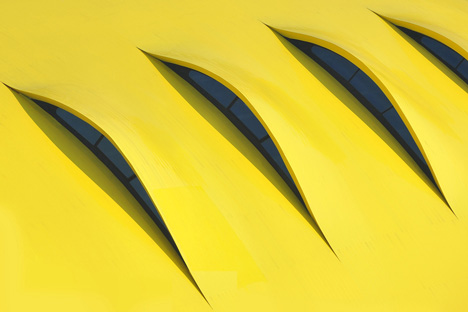
Following Kaplický’s death in early 2009, the Enzo Ferrari Museum has been completed by London practice Shiro Studio under the direction of former Future Systems associate Andrea Morgante.
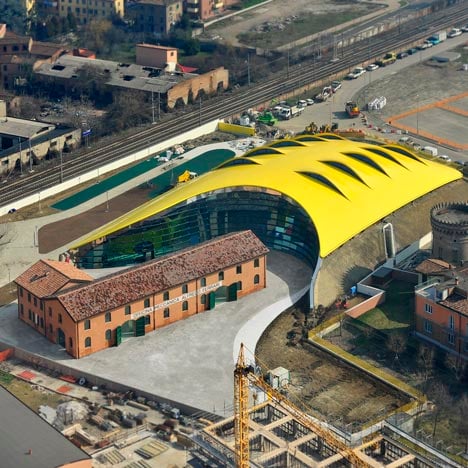
The museum comprises two buildings. The first is the early nineteenth century former house and workshop of Ferrari’s father, renovated to house a 40-metre-long gallery, while the second is a new glass-fronted structure that curves around it.
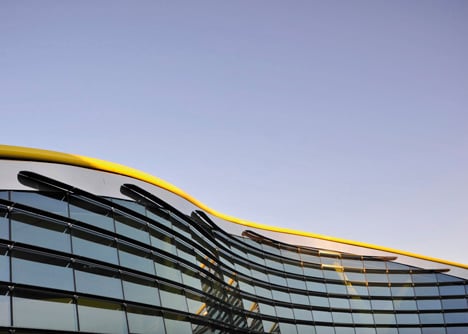
This new non-linear structure has a streamlined yellow aluminium roof that matches the colour of the Ferrari logo and features sliced incisions intended to resemble the air intake vents on the bonnet of a car.
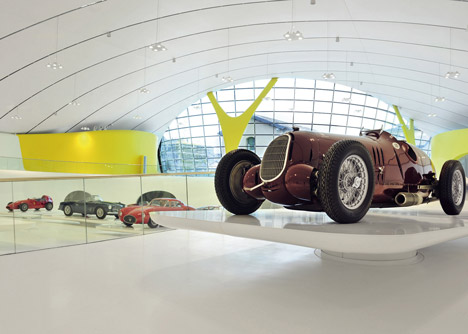
A gently-sloping ramp leads down into the building’s basement level exhibition hall, where up to 21 cars can be exhibited on a series of raised platforms.
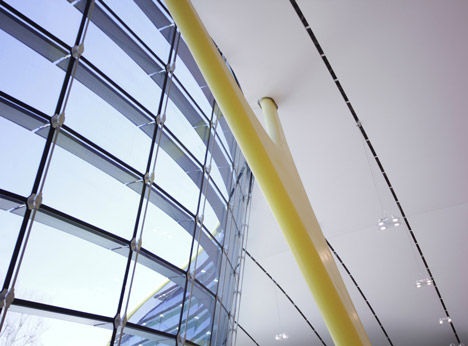
Above: photograph is by Andrea Morgante
An exhibition of models and key drawings spanning Kaplický’s career took place at the Design Museum the year he passed away - you can find photographs and a podcast from it here.
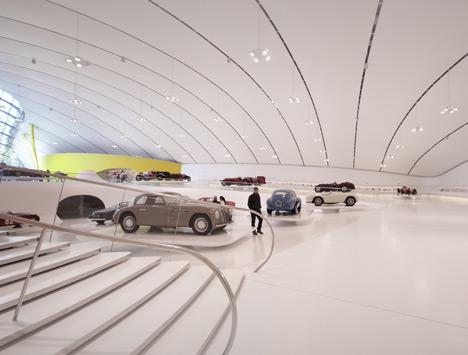
Above: photograph is by Andrea Morgante
Photography is Studio Cento29, apart from where otherwise stated.
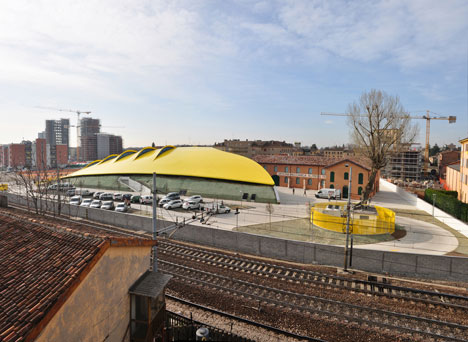
Above: photograph is by David Pasek
Here's a more comprehensive project description from Andrea Morgante:
Enzo Ferrari Museum, Modena, Italy
In 2004 Future Systems won an international competition to design a new museum in Modena, Italy. Dedicated to motor racing legend and entrepreneur Enzo Ferrari (1898 – 1988), the museum comprises exhibition spaces within the early nineteenth century house where the motor racing giant was born and raised, and its adjoining workshop, as well as a separate, newly constructed exhibition building.
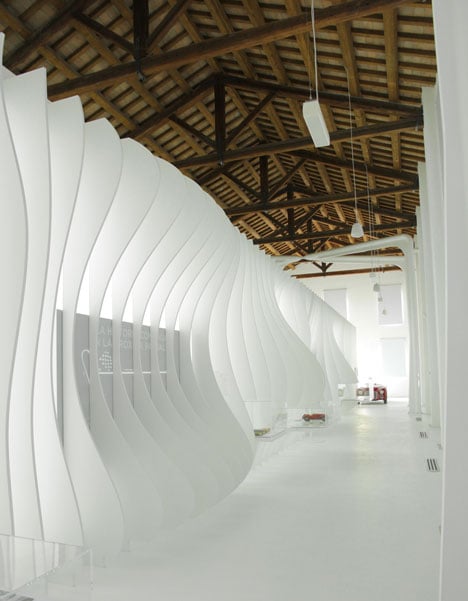
Above: photograph is by Andrea Morgante
Following the death of Jan Kaplicky in 2009, the office of Future Systems was dissolved ¹. Andrea Morgante, formerly of Future Systems and now director of Shiro Studio, was appointed to oversee the museum's completion. The new building has been constructed to Kaplický's original design– it is sensitive to the existing historical context, combines the latest in construction and energy saving technology, and resonates in spirit, language and materials with the cars it is intended to showcase. The fully restored house and workshop provide additional exhibition space designed by Morgante.
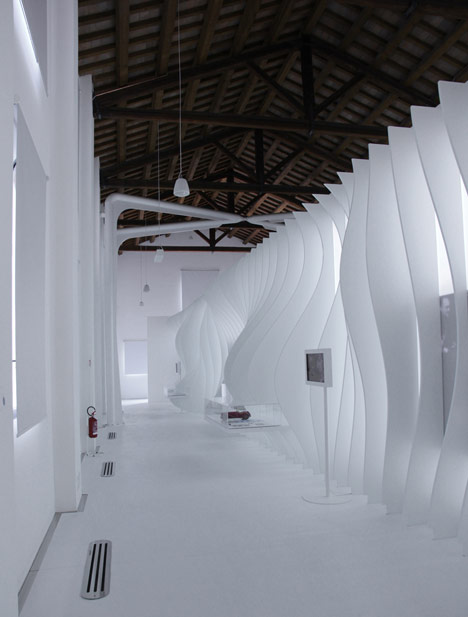
Above: photograph is by Andrea Morgante
New Exhibition Building
The sculpted yellow aluminium roof with its ten incisions – intentionally analogous to those air intake vents on the bonnet of a car – allows for natural ventilation and day lighting, and both celebrates and expresses the aesthetic values of car design. With its 3,300 square metres of double-curved aluminium, the roof is the first application of aluminium in this way on such a large scale. Working together with boat builders whose familiarity with organic sculpted forms and waterproofing made them the ideal partner, and cladding specialists, the form is constructed from aluminium sheets fitted together using a patented tongue and groove system. The bright Modena yellow of the roof is Ferrari’s corporate colour, as seen on the Ferrari insignia where it forms the backdrop to the prancing horse. It is also the official colour of Modena.
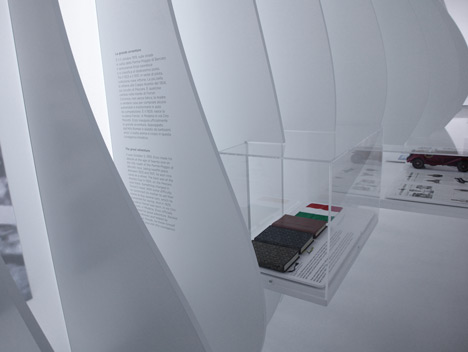
Above: photograph is by Andrea Morgante
Kaplický wanted to create a sensitive dialogue between the two exhibition buildings that showed consideration for Ferrari’s early home and underscored the importance of the museum as a unified complex made up of several elements. The views out of the new exhibition building dramatically frame the house and workshop, while views from outside the house and workshop immediately reveal the function and content of the new exhibition building. The height of the new exhibition building reaches a maximum of 12 metres – the same height as the house – with its volume expanding below ground level. In addition, the new building gently curves around the house in a symbolic gesture of appreciation.
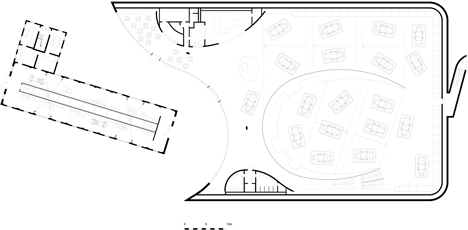
The glass façade is curved in plan and tilts at an angle of 12.5 degrees. Each pane is supported by pre-tensioned steel cables and is able to withstand 40 tonnes of pressure. The technical specification of these panes and cables means that greater transparency in the façade is achieved with maximum functionality. In the summer months a thermo-sensor activates the windows in the façade and roof allowing cool air to circulate. With 50% of the internal volume of the main exhibition building set below ground level, geothermal energy is used to heat and cool the building. It is the first museum building in Italy to use geothermal energy. The building also employs photovoltaic technology and water recycling systems.
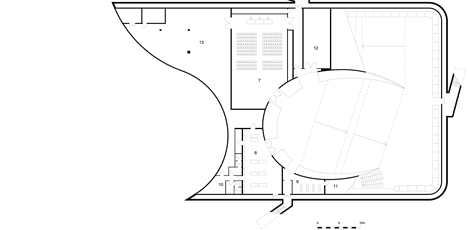
Visitors entering the new building have uninterrupted views into the entire exhibition space: a large, open, white room, where the walls and floor transition lightly into one another and are perceived as a single surface. A stretched semi-transparent membrane spreads light evenly across the roof, and in combination with the slits running from side to side which allow air to escape and give a ribbed effect, recalls the language of a car interior. A bookshop and café are situated to one side of the entrance and facilities to the other. Both are painted the same Modena yellow as the roof and take the form of blister-like pods. A gently sloping ramp gradually leads the visitor around the building from the ground floor to the basement level, with display stands designed by Morgante punctuating the circulation path. These stands lift the cars 45 centimetres so that they can be viewed from different angles and appreciated as works of art rather than objects simply placed in a room. Up to twenty-one cars can be displayed in this open space at any one time. Supplementary exhibition material is displayed in leather cases located along the perimeter wall. At the bottom of the ramp and directly below the entrance, an audiovisual room forms a permanent part of the exhibition. A flexible teaching space and a conference room with a carved out opening allowing views up into the entrance area are located next to it.
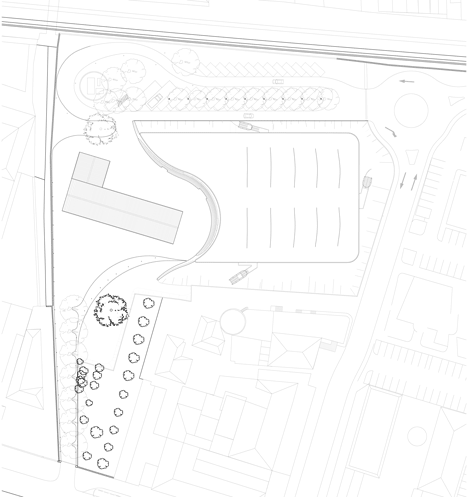
Restored House and Workshop
The two-storey house and workshop built by Ferrari’s father in the 1830s has been completely refurbished. Later additions to the house and workshop have been removed and, with the exception of two internal bracing structures that have been inserted in accordance with Italian anti-seismic regulations to give structural rigidity, no alterations have been made. The main gallery space is located within what was the double height workshop. Here Morgante has designed a contemporary exhibition display system, which incorporates digital projections, objects owned by Ferrari, information panels and other material.

The display system was conceived as a large-scale vertical book that allows the visitor to read the different chapters of Ferrari’s life through various media; a three-dimensional immersive biography. The system takes the form of a sinuous wall separated into pages, so that as visitors progress down the room, they are obliged to gradually discover each page and chapter in sequence. At every point the next chapter is concealed so as to maintain interest and create a sense of excitement. This organic landscape stretches through the entire length of the 40 metre long space and soft, low-level backlighting gently illuminates both it and the room, making the space intimate in spite of its size. At the northern end of the main gallery, in the original house, two smaller exhibition spaces are located next to one another. Administrative spaces are situated directly adjacent to them and on the first floor.

Client: Fondazione Casa Natale Enzo Ferrari
Location: Via Paolo Ferrari 85, Modena, Italy
Concept design: 2004
Completion date: 2012
Site area: 10,600 m²
Gross floor area: 5,200 m²
Contract value: €14.200.000

Architect: Jan Kaplický (Future Systems)
Project Architect: Andrea Morgante
Competition team: Jan Kaplický, Andrea Morgante, Liz Middleton, Federico Celoni
Project team (Preliminary, Detailed, Construction) (2005-2007): Andrea Morgante, Søren Aagaard, Oriana Cremella, Chris Geneste, Cristina Greco, Clancy Meyers, Liz Middleton, Itai Palti, Maria Persichella, Filippo Previtali, Daria Trovato.
Art Direction (2009-2012): Andrea Morgante (Shiro Studio)
Gallery Exhibition design: Jan Kaplický (Future Systems), Andrea Morgante (Shiro Studio)
Enzo Ferrari House Exhibition design: Andrea Morgante (Shiro Studio)

Project Management and Site Supervision: Politecnica- Modena
Structural, Mechanical & Electrical Design, Environmental Impact Assessement, Health & Safety (Preliminary, Detailed & construction stages): Politecnica

Main Contractor: Società Consortile Enzo
CCC soc. coop. (Leader), Ing. Ferrari s.p.a, ITE Group s.r.l, CSM.
Technical Director: Giuseppe Coppi (CdC – Modena)